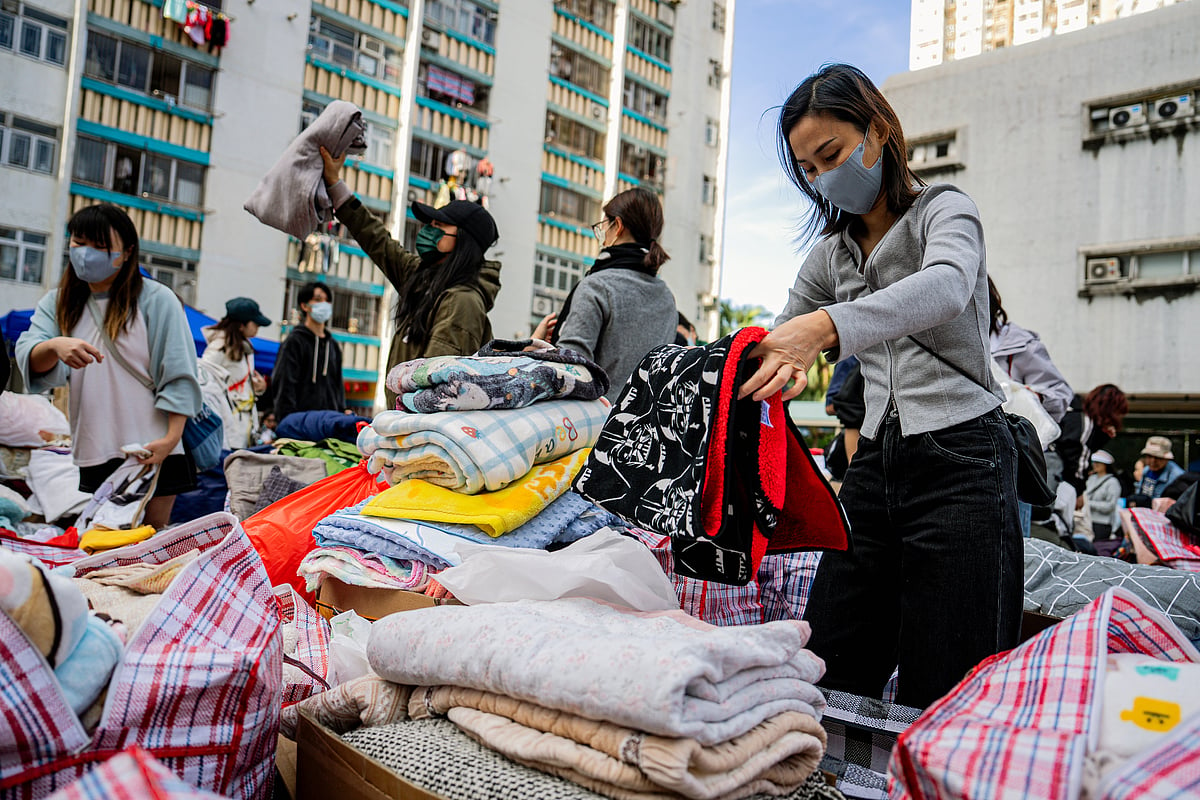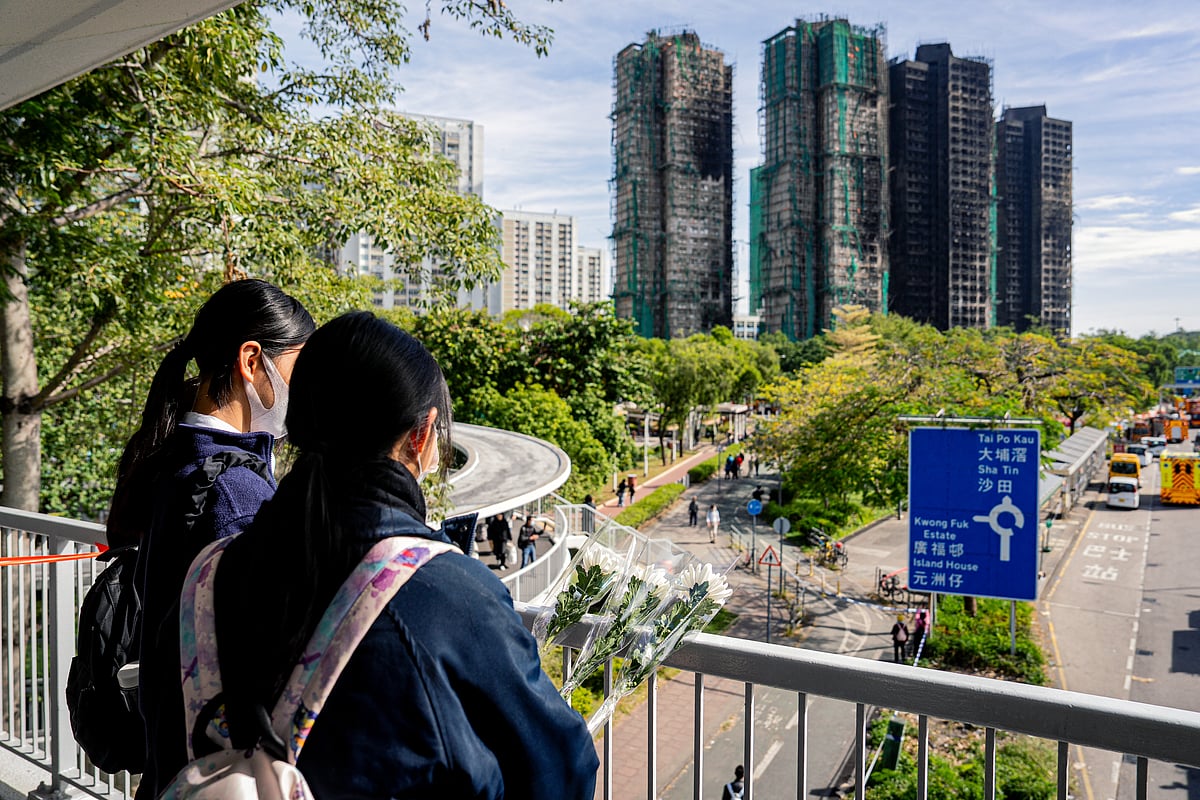Hong Kong Blaze Death Toll Climbs to 128, Arrests Widen
The status of roughly 200 residents remains uncertain, including 89 of the deceased whose identities haven’t been confirmed.

Hong Kong’s deadliest fire in nearly eight decades has killed at least 128, officials announced shortly after making fresh arrests in connection with the blaze.
Secretary for Security Chris Tang said at a Friday briefing that officials couldn’t rule out finding more bodies. The status of roughly 200 residents remains uncertain, including 89 of the deceased whose identities haven’t been confirmed.
Tang also detailed how construction materials erected for renovation work at the estate contributed to the rapid spread of the fire.
The blaze began Wednesday on the lower floors of a building in Wang Fuk Court, where netting wrapped around bamboo scaffolding caught fire and ignited highly flammable foam boards installed around windows. The intense heat also set the scaffolding ablaze, causing burning bamboo pieces to fall and ignite additional floors across the eight-tower complex in northern Hong Kong.
Director of Fire Services Andy Yeung said problems had been found with the fire alarms in the buildings, which produced no sound. The blaze is the deadliest in Hong Kong since a warehouse fire in 1948 that killed 176 people.
The Independent Commission Against Corruption said Friday it had arrested eight people linked to the estate’s renovation: two directors and two project managers of the engineering consultancy responsible for the work, three scaffolding subcontractors - including a married couple that owns the business - and a middleman. Two directors and a consultant from the contractor responsible for the renovation were arrested earlier on suspicion of manslaughter.
Inspections had flagged risks well before the disaster. Regulators conducted 16 checks on the renovation project and issued repeated written warnings urging the contractor to put proper fire-prevention measures in place — including as recently as last week, according to the Labour Department.
The company handling the HK$315.5 million ($40.6 million) renovation is also working on 11 other residential projects across Hong Kong, officials said.
“It’s premature to pass judgment on any officials or even on any companies involved, but I think government should take a good look at our existing legislation,” Hong Kong lawmaker Regina Ip said in a Bloomberg TV interview Friday.
That includes identifying any gaps in requirements for fire-retardant materials, whether for major works or small-scale renovations, and stepping up enforcement, she said.
Hong Kong Chief Executive John Lee visited the disaster site on Thursday. He earlier ordered a city-wide inspection of all housing estates undergoing major renovations. At a snap briefing, he said each affected family would receive HK$10,000 in relief. Flanked by several officials, he also pledged to completely phase out bamboo scaffolding in favor of metal alternatives.
The government announced on Friday that each affected household will receive an additional HK$50,000 in living allowance.
The unprecedented high-rise blaze comes at a delicate moment for Hong Kong. The global finance hub has been working to rebuild its international image after mass protests, a national-security crackdown and strict Covid controls drew criticism from some Western governments. Officials are days away from legislative elections — and Lee would be weighing whether to postpone them.
Across the city, several events have been canceled. Oxfam Hong Kong called off its popular Trailwalker fundraising race, while Disneyland scrapped a special screening and premiere of Zootopia 2. Other cancellations include the Standard Chartered Arts in the Park festival and a 10-kilometer race organized by Hong Kong Marathon Pro and the Pegasus Athletics Club.

While the broader economic impact should be limited, the tragedy points to deeper political problems, according to Gary Ng, senior economist at Natixis.
“A series of mistakes by various stakeholders ultimately led to the tragedy,” Ng said, adding that with so many aging buildings across Hong Kong, these issues must be addressed to prevent further economic, social and human losses.
The death toll has exceeded that of the Grenfell Tower fire in London, which killed 72 people in June 2017. That blaze was later deemed to be the result of a “catalogue of failures” by the government and construction industry. While that tragedy unfolded in the middle of the night as residents slept, this fire began mid-afternoon when many people would have been awake.

Renovation works at Wang Fuk Court were carried out by Prestige Construction & Engineering Co. Bloomberg News visited Prestige’s office on Thursday, but the shutters were down and no one responded despite repeated knocking. Phone calls to the office went unanswered.
Residents displaced by the fire will be sheltered in temporary accommodation. About 1,800 units of transitional housing will be made available — roughly equivalent to the estate’s entire housing stock.
Volunteers have rushed to the site and corporate donations have poured in, including from the Jockey Club, which pledged up to HK$170 million to support those affected.
Deadly fires have prompted major housing policy overhauls in Hong Kong in the past. Most notably, the Shek Kip Mei fire in 1953, which displaced tens of thousands of refugees, led to the start of the city’s public housing program, with the government providing resettlement housing for the residents.

